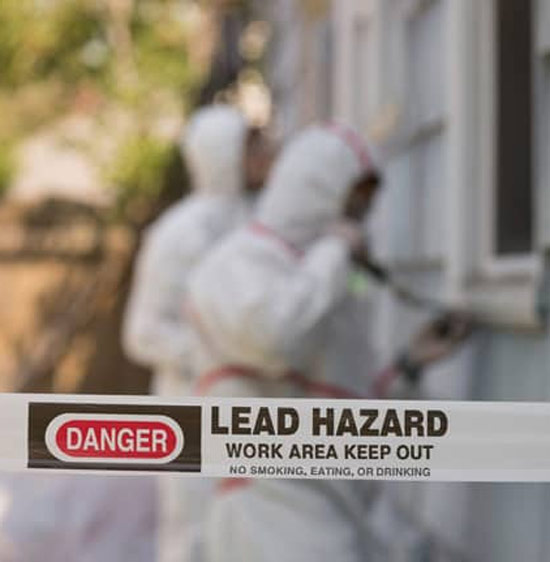Comprehensive Overview on Effective Lead Infraction Removal Methods
In the world of ecological safety and security, addressing lead offenses requires a careful and organized strategy. This comprehensive guide begins by highlighting the essential preliminary actions of identifying lead dangers via advanced assessment and testing methods. The guide elaborates on the importance of adhering to strict safety and security protocols throughout the removal process, including the usage of proper PPE and separating affected locations.
Recognizing Lead Threats
Identifying lead threats is a crucial initial step in minimizing the threats linked with lead exposure. Lead, a harmful steel, can be existing in different environmental mediums, consisting of paint, soil, water, and dust. It presents extreme health and wellness dangers, especially to youngsters and pregnant females, causing neurological damage and developing hold-ups. Precise identification of potential lead sources is essential for efficient remediation.
The preliminary stage in recognizing lead dangers includes recognizing usual lead resources within the built atmosphere. Structures built prior to 1978 are particularly prone due to the prevalent usage of lead-based paint throughout that period. Furthermore, soil contamination can occur from wearing away outside paint, commercial exhausts, or historical usage of leaded gasoline.
An additional significant resource is lead piping and plumbing components, which can leach lead into drinking water. Customer items such as playthings, ceramics, and imported items might additionally include damaging lead levels. Especially, occupational environments and pastimes involving lead can track pollutants right into homes.
Evaluation and Screening
When attending to lead risks, effective evaluation and testing are critical. This critical action makes certain the recognition and quantification of lead existence, therefore leading succeeding remediation efforts. First evaluation generally involves a visual evaluation to recognize prospective lead sources, such as degrading paint or contaminated dirt. This is complemented by more strenuous screening methods to identify the extent of contamination.

Dust wipe sampling is one more crucial technique, specifically in property setups. By collecting examples from floors, windowsills, and various other surface areas, this method supplies insights into prospective direct exposure dangers. Dirt testing around structure borders is crucial to detect lead contamination that could pose hazards, specifically to youngsters.
Safe Elimination Procedures
Upon completing extensive evaluation and testing, applying secure removal treatments is the following crucial phase in dealing with lead hazards. This process ensures that lead-contaminated materials are effectively and securely removed, lessening threat to both workers and citizens. The very first step includes separating the afflicted area making use of plastic sheet and correct sealing methods to avoid the spread of lead dirt.
Employees need to don proper individual safety tools (PPE), including respirators, gloves, and non reusable coveralls, to minimize direct exposure. Employing specialized devices and damp techniques, such as damp fining sand or making use of HEPA-filtered vacuum cleaners, lowers the diffusion of lead particles. It is important to prevent completely dry fining sand or unpleasant blasting, as these approaches can produce harmful lead dust.
Waste disposal is one more important component; all contaminated products must be safely gotten and labeled according to EPA and regional regulations. Furthermore, complete cleansing of the job area with HEPA vacuum cleaners and wet cleaning ensures the removal of residual lead bits.
Post-Removal Verification

Confirmation of effective lead removal, known as post-removal confirmation, is essential to make sure the safety and habitability of the remediated area. This examination ensures that all well-known resources of lead have been addressed and that no visible signs of contamination stay.
Following the visual evaluation, environmental sampling is performed. This includes gathering dirt, soil, and sometimes water examples from the remediated location. Accredited laboratories analyze these examples to gauge lead levels, guaranteeing they fall listed below the security limits established by regulatory bodies such as the Epa (EPA)
Furthermore, air top quality testing may be performed to spot airborne lead bits, specifically in situations where extensive lead-based paint elimination check my source or remodelling has happened. The results of these examinations give quantitative information confirming that the reference lead degrees are within permitted limits.
Ultimately, post-removal verification offers as an important checkpoint, verifying the efficiency of the lead reduction initiatives and guarding the health and wellness of owners and site visitors.
Safety Nets and Maintenance

A crucial preventative step consists of making use of lead-safe licensed contractors for any type of remodelling, fixing, or painting tasks. These professionals are learnt methods that decrease lead dust and particles. In addition, keeping painted surfaces to avoid cracking or peeling is crucial, as weakening paint can release lead particles right into the setting.
Educational efforts targeting homeowner and tenants concerning the threats of lead and the importance of reporting any type of prospective hazards can additionally enhance preventive initiatives. Regular cleaning utilizing HEPA vacuums and damp mopping methods can substantially decrease lead dirt accumulation.
Conclusion
In summary, effective lead violation removal requires a careful technique including complete assessment, precise screening, and rigid removal treatments. Recurring assessments and upkeep are vital to alleviate future lead risks, thus securing public health and wellness and link making certain continual conformity with governing needs.